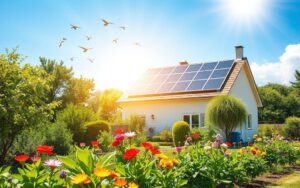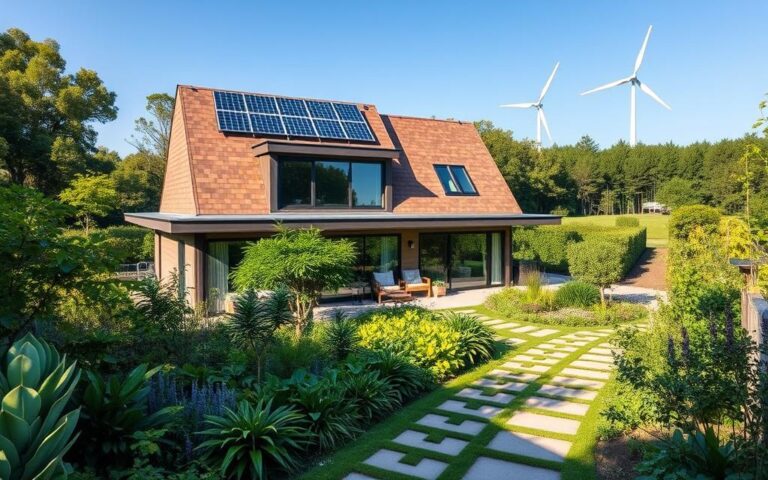Energy costs are going up, and worries about climate change are more urgent. The benefits of solar panels have caught the eye of many homeowners. Solar power offers a chance to save a lot on energy.
It also lets homeowners help build a sustainable future. By using eco-friendly power, solar panels lessen our need for fossil fuels. This reduces the carbon footprint. The move to solar energy marks a key step towards renewable energy sources.
This change is good for tackling the environmental impact of usual energy use. More Americans are choosing solar panels. Now is a great time to check out this amazing technology.

Introduction to Solar Energy
Solar energy is a powerful, sustainable electricity source from the sun. It uses sunlight and converts it into electricity with solar panels. These panels have photovoltaic cells made of special materials. When sunlight hits these cells, it generates electricity.
Solar power has become a strong alternative to fossil fuels. This is thanks to its environmental perks and falling costs. The U.S. Department of Energy shows a big shift toward solar power. From 2010 to 2020, solar capacity in the U.S. increased by over 400%.
Solar energy’s rise shows a shift in how we see renewable energy. It also shows our effort to cut carbon emissions and tackle climate change. With better technology, more families see the benefits of solar panels. This leads us to a greener future.
| Year | Installed Solar Capacity (GW) | Growth Rate (%) |
|---|---|---|
| 2010 | 0.5 | – |
| 2015 | 25 | 3800 |
| 2020 | 83 | 232 |
| 2023 | 130 | 56 |
Switching to solar energy helps households and the planet. It plays a huge role in our move toward renewable sources for a cleaner earth.
Understanding Solar Panels
Solar panels are crucial for converting sunlight into electricity. There are many types, each with its own use and benefits. We find monocrystalline, polycrystalline, and thin-film solar panels on the market, each differing in some key ways.
Monocrystalline panels are top-notch in efficiency and look. But, they cost more because they’re harder to make. They’re great when you’ve got little space but need a lot of power. On the other hand, polycrystalline panels cost less and still do a good job. They’re better for big projects where saving money matters more than using less space.
| Type of Solar Panel | Efficiency (%) | Cost (per watt) | Ideal Applications |
|---|---|---|---|
| Monocrystalline | 15-22 | $1.00 – $1.25 | Space-limited areas |
| Polycrystalline | 13-16 | $0.90 – $1.00 | Larger installations |
| Thin-Film | 10-12 | $0.70 – $0.90 | Large roofs or ground mounts |
Thin-film panels are light and bendy. They fit all sorts of places easily but aren’t as efficient as the others. Still, they’re perfect for big projects or places where regular panels won’t work.
Knowing the differences helps people pick the right solar panels for their needs. Consider what’s most important: efficiency, cost, or where it’ll go. This way, you can choose the best option for your home.
Benefits of Solar Panels
The benefits of solar panels go well beyond just cutting down on electricity costs. Homeowners can enjoy major energy savings, leading to more financial freedom. The Solar Energy Industries Association (SEIA) reports that an average homeowner saves a lot of money through their solar system’s life. These savings come from smaller utility bills and possibly higher property values. Homes with solar panels often are worth more.
Putting money into solar technology brings significant money benefits. Many installations of solar panels get federal tax incentives, making them even more attractive. It’s key for homeowners to understand these financial perks to make better energy spending choices.
The positive effects of solar energy on the environment are also huge. Solar panels greatly cut down on fossil fuel use. This leads to fewer greenhouse gas emissions. This shift helps not just the homeowner but the whole planet’s environmental wellbeing. This is a big reason why solar technology is getting more popular.
| Benefit | Description |
|---|---|
| Cost Savings | Reduces monthly utility bills and provides significant long-term savings. |
| Increased Property Value | Homes with solar installations often sell for higher prices. |
| Tax Incentives | Eligibility for federal and state tax credits to offset installation costs. |
| Environmental Benefits | Lower greenhouse gas emissions and reduced fossil fuel dependency. |
Renewable Energy and Its Importance
Renewable energy is key in fighting climate change worldwide. It includes energy sources like wind, solar, and hydro power. These sources are important because they help cut down on harmful emissions and lessen our need for fossil fuels. Solar energy stands out for its ability to turn sunlight into electricity using photovoltaic systems.
Solar energy is becoming crucial in using renewable resources. Thanks to advancements, solar panels are now more efficient and cheaper. This allows both homeowners and businesses to use solar power easily. By adopting solar energy, people are helping to build a sustainable future and lowering their environmental impact.
According to the International Renewable Energy Agency (IRENA), renewable energy is growing fast. The U.S. is installing more solar energy systems each year, showcasing a move to cleaner energy. This growth highlights a rising commitment to sustainability.
The increase in renewable energy usage brings the U.S. closer to energy independence. Using solar energy reduces our need for foreign oil and improves energy security.
| Year | Solar Energy Capacity (GW) | Estimated Growth (%) |
|---|---|---|
| 2015 | 25 | 20 |
| 2020 | 97 | 29 |
| 2023 | 133 | 37 |
Investing in renewable, especially solar energy, is good for both the planet and the economy. As solar energy becomes more popular, it creates jobs in the solar sector. This helps develop a more sustainable economy for everyone.
Environmental Impact of Solar Energy
Solar energy brings big benefits for our planet. It lets homeowners use less fossil fuels. This means they release less carbon into the air.
Switching to solar power fights air pollution and makes the air cleaner. This is good for both our health and the earth.
It’s important to understand how solar panels are made and used. They go through several steps: getting materials, making the panels, setting them up, and finally recycling them. Some worry about the resources used to make them.
But studies show the energy solar panels produce is more than the energy needed to make them. This makes their environmental impact much smaller.
Research says that solar panels are still good for the environment when it’s time to throw them away. Recycling them helps by getting back useful materials. This makes solar power even more sustainable.
Some major wins of using solar power are:
- Less greenhouse gas emissions
- Less use of non-renewable resources
- Better local air quality
- Boost for sustainable development
Solar energy is a key part of a green energy future. It leads to cleaner air and a healthier earth for everyone.
| Aspect | Before Solar Energy | After Solar Energy Adoption |
|---|---|---|
| Carbon Emissions | High | Significantly Lower |
| Air Quality | Poor | Improved |
| Energy Source Reliance | Fossil Fuels | Renewable Sources |
| Waste Management | Traditional Waste | Recycling Potential |
Solar Incentives for Homeowners
Investing in solar energy is a wise financial move for homeowners. There are various solar incentives like federal tax credits, state-specific rebates, and local grants. These can cut down the costs of getting solar installed.
The Federal Investment Tax Credit (ITC) helps you save by letting you deduct some of the installation costs from your federal taxes. Right now, this credit lets you deduct 30% for systems put in place by the end of 2032. This makes it easier for homeowners to switch to solar energy.
State programs also offer rebates to bring down the cost even more. Every state has its own programs, which are listed in resources like the Database of State Incentives for Renewables & Efficiency (DSIRE). This resource is great for checking out your options.
Local grants are another way to make solar more affordable for more people. These solar incentives don’t just make it cheaper to start. They also support the move towards renewable energy, aiming for a greener future.
| Type of Incentive | Description | Example |
|---|---|---|
| Federal Tax Credit | Percentage deduction on federal taxes for solar installation costs. | 30% deduction for systems installed by 2032. |
| State Rebates | Financial rebates provided by state governments to reduce solar costs. | $1,000 rebate in certain states. |
| Local Grants | Funding offered by local governments or organizations to support solar energy. | Grants averaging $2,500 in some communities. |
The Process of Solar Installation
Learning how solar installation works is key for homeowners thinking about this green energy option. It starts with figuring out your home’s energy needs. Knowing how much electricity you use helps design the right system for you.
After identifying your energy needs, the next step is to get the right permits. Local rules decide what permits you need for solar installation. Talking to your local officials makes sure you follow the rules and keeps installation moving smoothly.
Finding the right installer is very important. Choose a trusted company known for installing solar panels. Look at reviews, get suggestions, and check for certifications to ensure high-quality installation.
The installation includes important steps:
- Checking the site to see where the solar panels should go.
- Putting the solar panels up securely on your roof or on the ground.
- Connecting the solar panels to the inverter and your house’s power system.
- Doing final checks to make sure everything is safe and correct.
Having a pro do the installation is essential. A skilled contractor knows the details of the process. This means less risk and better performance of your solar system.
For a clearer picture of the process and its parts, see the table below. It shows the key steps in solar installation:
| Step | Description |
|---|---|
| Assessment | Figure out energy needs and if the site fits. |
| Permits | Get the needed local and state permits. |
| Installer Selection | Pick a certified and skilled solar installer. |
| Mounting | Set up the solar panels on chosen structures. |
| Connection | Connect panels to inverter and power system. |
| Inspection | Do final safety and compliance checks. |
Choosing the Right Photovoltaic Systems
Picking the right photovoltaic systems for your home needs careful thought. The first step is to know how much energy you use. Figure out your monthly electricity need and find a system that can handle it. This makes sure the system can meet your family’s needs well.
Your roof’s size and how it’s facing are key in choosing a system. Bigger roofs can fit more panels. Also, if your roof faces south, it will get more sunlight. This makes the system work better.
Shading can lower the energy your system makes. Nearby trees or buildings might block sunlight. Checking how much shade there is during the day helps find the best spot for the panels.
It’s also good to look at different models based on their efficiency and warranties. Models that are more efficient might cost more at first but produce more energy later on. Warranties show how long a system might last and its quality. Below is a table that lays out these points:
| Feature | Considerations |
|---|---|
| Energy Consumption | Analyze average monthly usage to ensure adequate system size. |
| Roof Size | More space allows for more panels; assess potential capacity. |
| Orientation | South-facing roofs typically provide maximum sunlight exposure. |
| Shading | Evaluate shading throughout the day to determine panel placement. |
| Efficiency Ratings | Higher efficiency can result in better long-term energy production. |
| Warranties | Consider warranties as indicators of system longevity and reliability. |
Maintaining your photovoltaic system is key to making it last and work well. Cleaning it often and having regular checks can boost its performance. This ensures your system keeps giving benefits over the years.
Energy Independence with Solar Power
Solar power is a key to more energy freedom for homeowners. It lets people make electricity from sunlight. This reduces dependence on big utility companies. Homeowners can gain control and save money over time.
Solar energy systems shine during power outages. They keep the lights on when the grid is down. This makes sure important devices stay on. It’s especially vital in places where storms often knock out power.
Going solar can save a lot of money. Homeowners generate their own power and cut their energy bills. Government incentives make these savings even bigger. This makes solar a cost-effective choice for the long run.
Studies have shown that using solar energy really brings down energy costs. As solar tech gets better, these systems become more efficient and cheaper. This makes more people want to switch to clean energy.
The shift to solar power offers homeowners energy independence and reliability. It secures their energy needs and helps the planet. Going solar is a step towards a greener, more sustainable future.
Sustainable Living with Solar Energy
Adding solar energy to your home helps you live more sustainably. Many homeowners choose solar power not just to cut energy costs but also to lessen their ecological impact. Solar panels give us a clean, endless energy supply, reducing our use of fossil fuels.

Small, everyday changes can lead us toward a greener lifestyle. Homeowners might consider these steps:
- Implement energy-efficient appliances to complement solar energy use.
- Practice mindful energy consumption by turning off lights and electronics when not in use.
- Participate in local recycling programs and composting initiatives.
- Explore options for electric vehicles powered by renewable energy.
More and more Americans are switching to eco-friendly homes, and solar power is leading the way. Studies reveal a significant increase in solar adoption over the last ten years. Now, millions of American homes produce their own solar electricity. This change shows our dedication to living sustainably and highlights a wider move toward being mindful of our planet.
Using solar energy as part of a bigger sustainability plan makes a huge difference. Every choice to use green energy builds up, encouraging others to do the same. It’s all about making choices that inspire change and help the environment.
Conclusion
Solar panels offer more than just savings. They mark a move towards renewable energy. This lets homeowners use a clean and endless energy source. It greatly cuts down their impact on the planet.
This action slashes electric bills and helps our planet. Future generations will thank us.
Living sustainably is crucial. Using solar energy is a key part of this effort. It shows we care about protecting our world. As technology improves, solar power will become a top energy choice.
Choosing solar energy is a big step for a greener tomorrow. When more people install solar panels, it creates a big change. It pushes society to embrace renewable energy. Now is the perfect time to switch to solar. It brings benefits now and helps the Earth in the long run.
FAQ
What are the main benefits of solar panels for homeowners?
Solar panels offer big savings on electricity bills. They also boost your home’s value. Plus, they’re good for the planet by cutting down carbon emissions. Homeowners may get solar incentives, making installation cheaper.
How do solar panels impact the environment?
Solar panels provide green power, cutting back on fossil fuel use. This reduces pollution and greenhouse gases. They help us shift to sustainable energy sources.
What factors should I consider when choosing a photovoltaic system?
Think about your home’s energy needs and your roof’s size and direction. Check for shading and panel efficiency. Always compare warranties to get the best performance and longevity.
Are there any financial incentives for installing solar panels?
Yes, homeowners enjoy perks like federal tax credits and state rebates. Local grants can also cut initial solar panel costs. These incentives make solar energy more affordable.
How does solar energy contribute to energy independence?
Solar power lets homeowners create their own electricity. This lowers reliance on external power systems. It ensures a steady energy supply, even when there are outages.
What is the typical installation process for solar panels?
The process starts with evaluating your energy needs. Then, you get the right permits and pick a good installer. Choosing a trusted contractor ensures safe and efficient setup.
How can I ensure my solar panels are maintained effectively?
Keep your panels clean and check for any shading or debris. Make sure the inverter and wiring work well. Talk to your installer for maintenance tips to keep panels efficient.
What are the key components of sustainable living with solar energy?
Using solar power for daily needs is crucial. Aim to use less energy overall. Adopt eco-friendly habits like recycling and saving water. These steps reduce your environmental impact.




